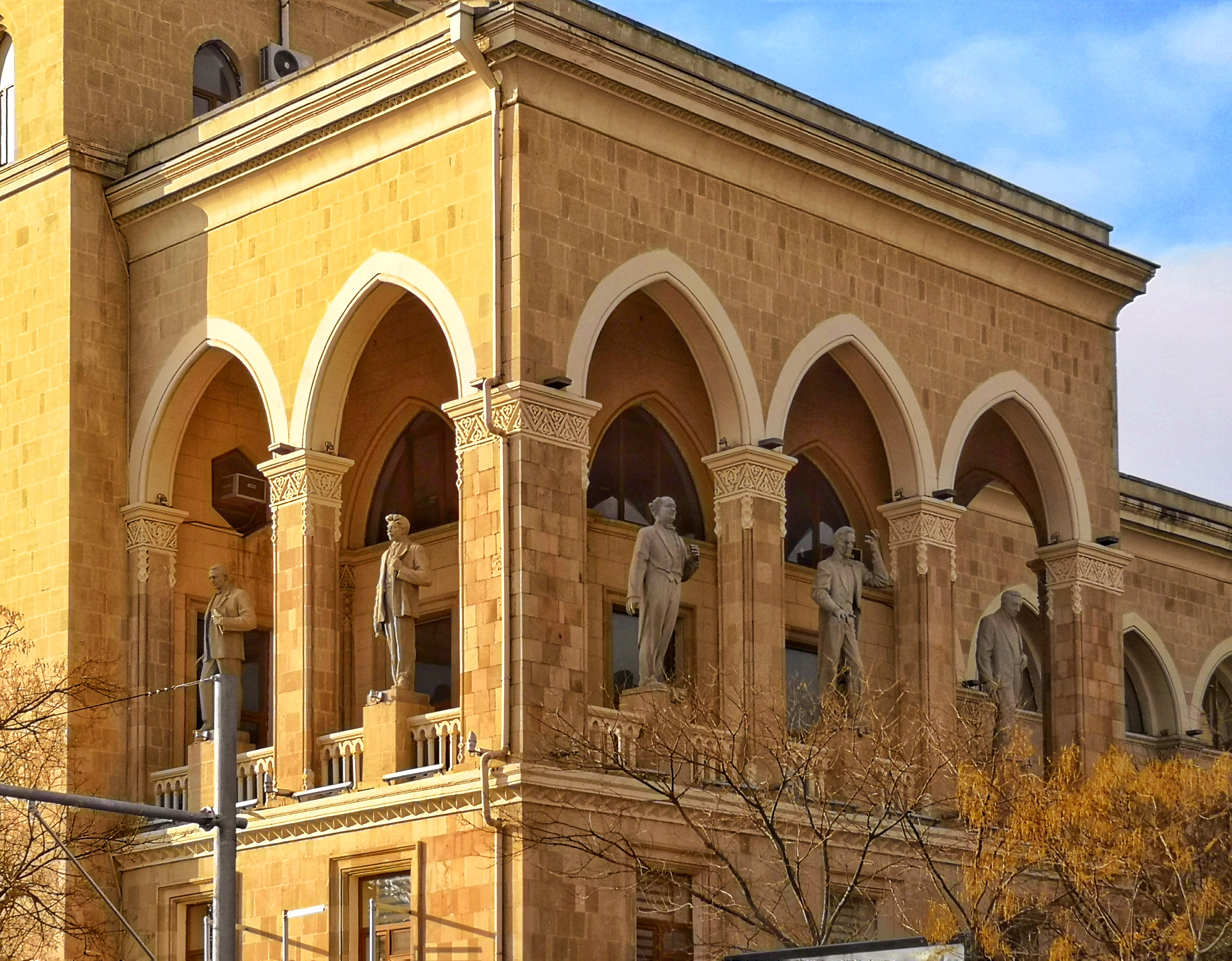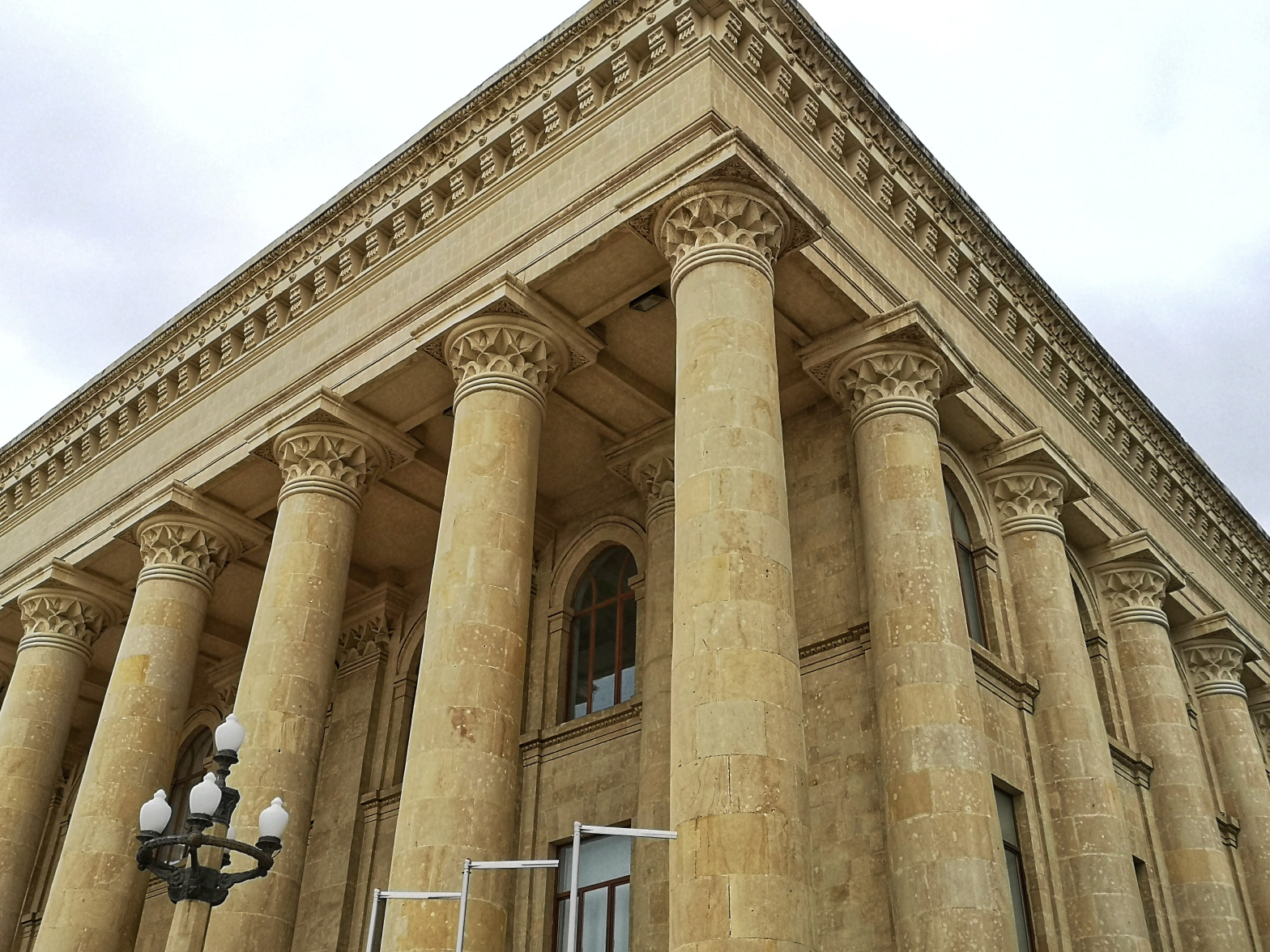The capitalist era of development in Baku ceased to exist with the establishment of the Azerbaijan Socialist Soviet Republic in 1922. Socialism became the primary means to achieve modernity, enlightenment and human progress in society. The soviet political leadership acquired unchallenged power, and state interference in every aspect of social, political and economic life was definitive.
Meanwhile, Baku, the capital city, grew larger and bigger in terms of territory and population, which paved the way for a new term: Greater Baku. Oil was still a crucial factor, however, Baku was no longer solely an exporter of crude oil, but also oil expertise and technology to the Soviet Republics. It became the “oil academy” and contributed to discoveries all over the Soviet Union. Thus, Baku was not just a cosmopolitan city with diverse social classes and ethnicities, but also an urban habitat with high social capital.

Equally important, architecture became subject to the changing tastes of the Soviet leaders. Every leader would enact a developing policy about how architecture should be. Thus, the architecture of Soviet Baku evolved from constructivism (Baku constructivism during the 1920s-1930s) to the Stalinist Empire style (Socialist realism, National Romanticism during 1933-1954). The Khrushchev era saw the rise of architecture coined as Soviet modernism (Baku socialist modernism) which lasted until the fall of the Soviet Union.
Constructivism: Breaking with European eclecticism
Constructivism was a popular modern architecture movement in the early years of socialism in Baku, during the 1920s and early 1930s. The constructivist movement combined technological innovation with modern engineering methods and the values of socialism, which resulted in stylistically abstract, bold geometric masses and shapes.

Constructuvism | Bayil Culture House (1927-30) | Architects: Alexandre Vesnin and Leonid Vesnin

The principles of constructivism largely reflected the revolutionary political and social environment of the era. All endeavours aimed at searching for new architectural solutions for the urban planning and housing needs of workers. It brought an end to half a century’s dominance of European eclecticism in Baku’s built environment. Baku was no longer the “Paris of the Caspian,” a modern European city, but a “city for the New Soviet man.”
Many architects embraced constructivism during the 1920s. Among the leading proponents were the Vesnin brothers, one of whose first constructivist projects was to build a workers’ town, a complex of a residential neighbourhood with houses, social services and green public spaces, in Baku in 1925. Because of the expansion of Baku’s oil fields, the earliest grand constructivism projects focused on the construction of experimental socialist residential neighbourhoods to facilitate communication to the oilfields. Moreover, constructivist architects attempted to shape the way humans interact outside their family house by designing kitchen factories and culture houses, which were common spaces where the workers shared to spend their work and leisure time respectively.
The most notable development of the era, however, was the construction of the constructivist residential block no 171 (aka Ermenikend), an approach that has been seen by many as the birth of the socialist residential superblock. Another grand landmark of constructivism in downtown Baku is Semen Pen’s project of the “Press Palace,” or “Azerneshr,” constructed in 1932.
Stalinist Empire: Socialist realist architecture
The approval for the construction of the magnificent Palace of Soviets by Boris Iofan in Moscow in 1933 marked the beginning of the return to monumental historicism. The architecture of this era is known as Socialist realism or alternatively as the Stalinist Empire style (Stalin’s Socialist realism).



The architecture of this era featured monumental landmarks similar to ancient Greco-Roman temples with massive pediments and theatrically displayed grand arcades and colonnades. Hasan Majidov’s architectural imagination posited these distinctive features in his works of Museum Centre (formerly the Lenin Museum) and the Culture House of the State Security Service (formerly the Dzerzhinsky Club).

However, Boris Iofan’s magnificent project having never been realised, the process of the construction of Baku’s Palace of Soviets (now Government House, by Lev Rudnev and V.O. Munts) during 1934-1952 had a paramount impact on developing a local style of Socialist realism in Baku. It led to the process of systematically studying Azerbaijan’s local architectural traditions from Icherisheher and the medieval castles of Absheron to Sheki Khan’s Palace and the historical landmarks of Karabakh and Nakhchivan.


In Azerbaijan, this era created a suitable environment for Azerbaijani architects to produce a national style that came to be known as Azerbaijani national romanticism. This architecture advocated the adoption of decorations, ornaments and tall and large archways that were rooted in Oriental and Azerbaijani culture.

Mikayil Huseynov and Sadig Dadashov were the leading proponents of this movement. The Azerbaijan Pavilion in Moscow in 1939 earned them a Stalin Prize, which validated their style based on national culture and Oriental ornaments. The completion of the residential apartment blocks “Buzovnaneft,” “Azneftzavod” and “House of Scientists,” after World War II solidified their reinvention of the national style, this time with the added influence of Moorish architecture. One of the duo’s most remarkable works was remodeling the old neoclassical Metropol Hotel into the national romanticist Nizami Museum with a loggia (western façade), tall pointed arches on a background of blue tiles designed by Latif Karimov, the founder of the Azerbaijan Carpet Museum.
The untimely death of Sadig Dadashov was a great loss in Azerbaijan’s Soviet architecture. Nonetheless, Mikayil Huseynov went on to create one of the greatest works, the complex of the Academy of Sciences, which was constructed in 1951-1966 (the project was designed in 1948). Huseynov’s approach to designing the group of monumental buildings followed the philosophy of Moscow’s Seven Sisters, magnificent skyscrapers built in the Stalinist Empire style. Nonetheless, Huseynov stayed loyal to his national style, including grand pointed arches, golden Oriental capitals and red-granite columns. Khrushchev’s rise to power prevented the completion of the grand central structure with majestic domes on each top corner, as had been projected.

On a pure pop-culture level, there is a general public belief that some of the glorious soviet architecture from the Stalinist era, such as the Government House, “Buzonvaneft” Residential Apartment and even the Stadium named after Stalin (Tofiq Bahramov Republican Stadium) has used the labour of German War Prisoners of the WWII. Nonetheless, the official sources have never acknowledged these accounts about the use of PoWs in the construction, nor any other declassified archive document has clearly revealed to the public.
Soviet modernism: the empire’s last style
The Khrushchev era saw the rise of architecture coined as Soviet modernism and it lasted until the fall of the Soviet Union. The period 1955-1991 radically changed approaches to architecture and in particular urban planning. Rooted in the Russian avant-garde, Soviet modernist architecture was primarily oriented towards utilitarian purposes, whereas decorations and ornaments on buildings were rejected.


The main objective put before architects was to find a solution to the housing shortages of Soviet families, and the solution had to be accomplished economically. This is when massive, monotonous and austere matchbox-like buildings appeared in the built environment of Baku. The individual approach to finding architectural solutions was replaced with mass production and aesthetic beauty was dumped in favour of functionality.
Nonetheless, the proponents of Soviet modernism argue that it should be judged by its distinctive features: plasticity, transparency, airiness, spatial complexity, innovative methods of using contemporary materials, refinement of details, novelty and abstract imagery, and beauty of contrasting forms.

Moreover, local modernist architectural trends emerged from Soviet modernism, which gave rise to the autochthon style of modernism in the Caucasus. Some Azerbaijani architects even went further by identifying the period 1975-1985 as the era of Baku socialist modernism.
This era brought more plurality to the Soviet architecture of Baku, with the participation of more local architects such as Talat Khanlarov, Enver Ismayilov, Yuzef Kadimov, Abram Surkin, Vadim Shulgin, along with Mikayil Huseynov. Equally important, Azerbaijani women architects, such as Shafiga Zeynalova and Zeynab Guliyeva, brought an end to the monopoly of men in the architecture of Azerbaijan by creating equally great masterpieces during this era.





Baku also has iconic landmarks representing Soviet modernism that deserve publicity, acclaim and praise. There are numerous experimental residential apartments that exceptionally stand out, however, most of the masterpieces are public and administrative offices, sports complexes and concert halls.
Undeniably, the mega architectural project of the era was the construction of Baku Metro, a fast public transport system that connects the peripheries with the city centre. The project has been a developing construction that develops for the last 54 years. The design works have been used for a showcase of glorifying Soviet power and socialist achievements in AzSSR. It has been inaugurated with 5 metro stations and 9.2 km in 1967 initially, but now it has 26 stations stretching over 38 km in every direction of Baku. The “Nizami” and “Elmler Akademiyasi” metro stations are great artworks of combining a socialist project with the expression of Azerbaijani culture.


Apart from the new residential houses and administrative offices, Baku also underwent massive gentrification during this era under the leadership of the mayor, Alish Lambaranski. The Seaside Boulevard was redeveloped and extended to become an egalitarian public site for cultured leisure. Various facilities such as the Puppet Theatre, a summer cinema, a chess club, Little Venice (a replica of Venice as a recreational site), Swans Fountain and teahouses such as the Pearl cafe enabled access to iconic landmarks of the city democratically. The square called “Parapet,” later redeveloped into today’s Fountains Square, and Molokan Garden had fountains built with aesthetically sculpted “three graces.” All these added layers enriched the city’s image during the tempestuous history of Soviet architecture in Baku.


Legacy
Although short-lived, lasting for about 70 years, the era of Soviet architecture in Baku left a diverse, elaborate and admirable heritage. It adds another layer of internationality to the urban development of Baku. Although the Soviet architecture of Baku might have radical and non-traditional features, it adds value and blends very well into the evolution of Baku’s architectural identity.














1 Comment